19.12.2009 - 4.1.2010
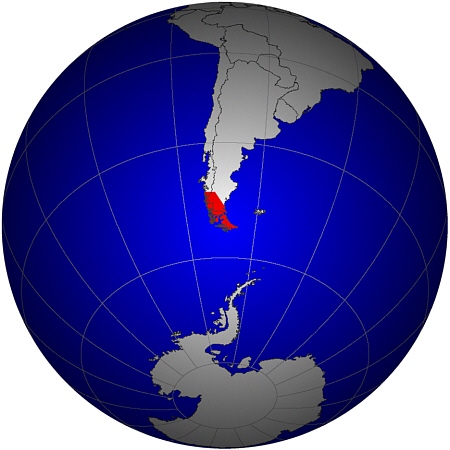
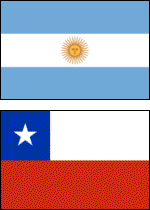 As the target for the holidays at the end of the year I had me predestined this time an area on the southern hemisphere.
This time it should go to the end of the world, Patagonia and Tierra del Fuego.
These days Argentina and Chile share this part of South America more or little peacefully.
As the target for the holidays at the end of the year I had me predestined this time an area on the southern hemisphere.
This time it should go to the end of the world, Patagonia and Tierra del Fuego.
These days Argentina and Chile share this part of South America more or little peacefully.
I decided to do traveling again with Rotel Tours, because of past experiences.
It's itinerary led by the southern parts of Argentina and Chile.
Although it is primarily a tour by bus on the road, but one can undertake relatively many hikes.
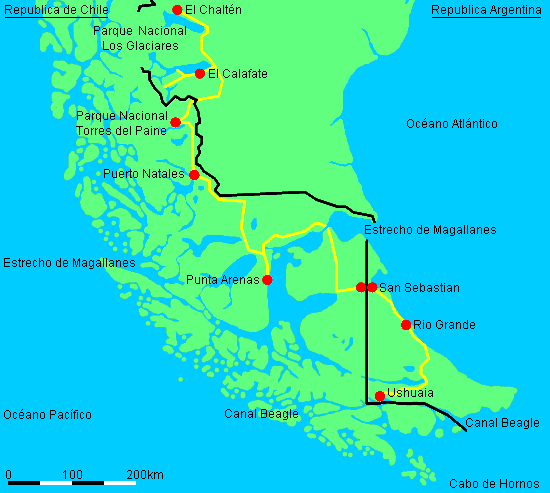 Day 1: flight to Buenos Aires (LU)
Day 1: flight to Buenos Aires (LU)
Day 2: Buenos Aires, flight to Ushuaia (LU)
Days 3 - 4: Ushuaia (LU)
Day 5: San Sebastian (CE)
Day 6: Punta Arenas (CE)
Days 7 - 9: Paine N.P. (CE)
Day 10 - 11: El Chaltén (LU)
Days 12 - 14: El Calafate (LU)
Day 15: flight to Buenos Aires (LU)
Day 16: Buenos Aires (LU), flight to Germany
Day 17: arrival in Germany
Guest licenses and radio station 
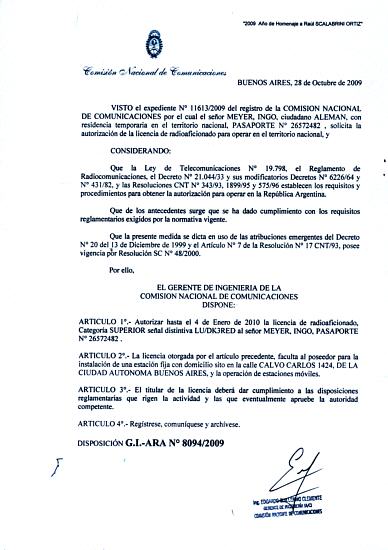 Already at selection of travel I have planned to become active as amateur radio operator from South America.
The information from OH2MCN were promising.
And so it went within five to six weeks with the guest licenses.
Requires only copies of the own licence and passport and a completed application.
At the Radio Club Argentino (RCA) you will find the necessary material and the correct email address on the page "Radio Permit in Argentina".
Already at selection of travel I have planned to become active as amateur radio operator from South America.
The information from OH2MCN were promising.
And so it went within five to six weeks with the guest licenses.
Requires only copies of the own licence and passport and a completed application.
At the Radio Club Argentino (RCA) you will find the necessary material and the correct email address on the page "Radio Permit in Argentina".
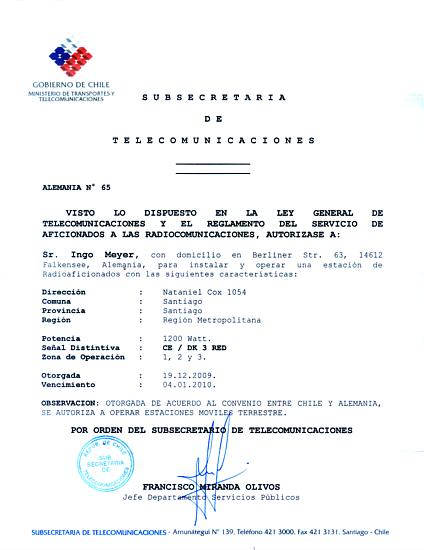 At the Radio Club de Chile (RCC) it is necessary to request the form on the page "Contactenos".
One will send it you immediately via email.
At the Radio Club de Chile (RCC) it is necessary to request the form on the page "Contactenos".
One will send it you immediately via email.
Both guest licenses are free of charge and radio clubs take entire cooperation with public authorities.
There is no charge.
I considered suitable to honour all the work at least respective with a donation for the QSL bureau in form of IRC's.
The guest license for Chile (CE/DK3RED) arrived before departure from Germany.
In Buenos Aires, I got my guest license for Argentina (LU/DK3RED).
It is better to specify an address in Argentina, where the license can be sent.
This will speed up the matter very.
In my case it was the first hotel.
As CW station in the luggage was my Elecraft K1 (40 to 17 m, 5 W) in addition to an Up & Outer as antenna and a DK9SQ fiberglass pole.
It was already clear in my mind that I could be active only at night because I wanted to see primary in the daytime the land and the people there.
Ham radio operation would then have a nice job in the evenings.
I become wiser since my travel across South Africa and the withal pulled out zipper at the bag.
Although I put inside the new bag again my radio station but let it this time unlocked.
Therefore it would have been possible at any time for the security service to check what lies in it without ruining the bag.
The pole started as usual his journey at the bulky luggage counter.
At the end of the world 
As I take off at the day 1 from Germany, the thermometer showed there -13 °C, so that the aircraft had to be deiced.
When landing in Buenos Aires there reigned in the late evening still 28 °C with a very high humidity.
I felt more like a drop of water on the hot cookers.
You could probably lying down to withstand well this climate at the water or pool.
To all accident my antenna pole missing upon arrival in Buenos Aires, what isn't increased my mood.
It should be forwarded to me either in the hotel in Buenos Aires or immediately after Ushuaia, when it arrived.
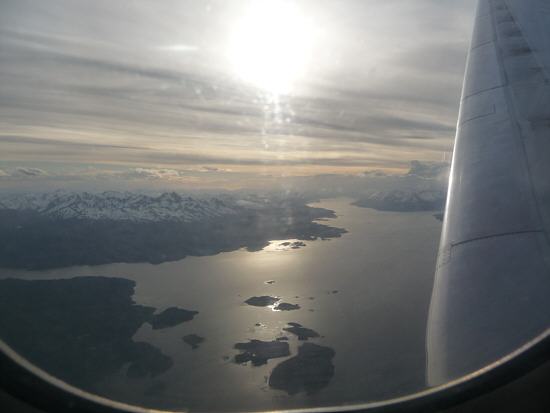
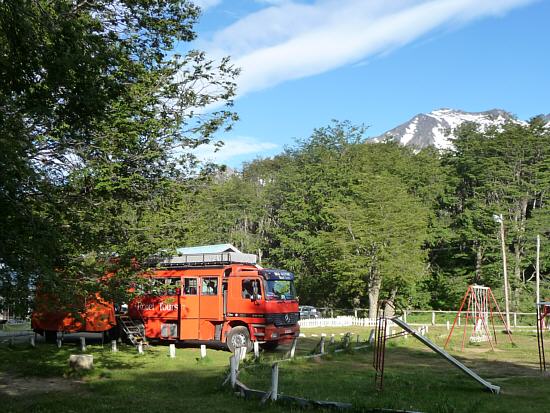 Also a city stroll in the morning of the day 2 I could not friends myself really with this hot city and its crowds of people.
Fortunately it went in the afternoon finally further by airplane via El Calafate to Ushuaia.
From the airplane were to see the first snowy mountains and many surfaces of water (photo left).
Ushuaia is one of the southernmost cities in the world.
It served us in the next two days as a starting point for excursions by bus and foot and by boat (photo right).
Also a city stroll in the morning of the day 2 I could not friends myself really with this hot city and its crowds of people.
Fortunately it went in the afternoon finally further by airplane via El Calafate to Ushuaia.
From the airplane were to see the first snowy mountains and many surfaces of water (photo left).
Ushuaia is one of the southernmost cities in the world.
It served us in the next two days as a starting point for excursions by bus and foot and by boat (photo right).
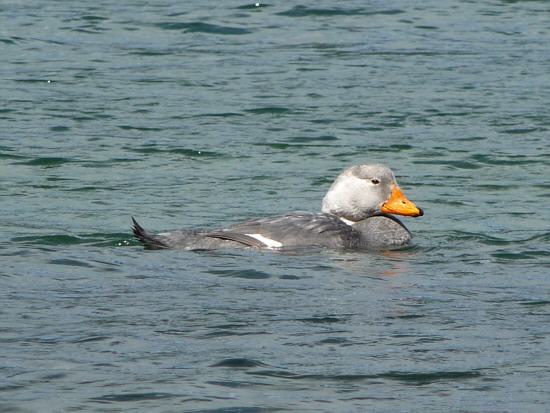 At the day 3 it goes from Ushuaia in the west situated National Park Tierra del Fuego.
At the day 3 it goes from Ushuaia in the west situated National Park Tierra del Fuego.
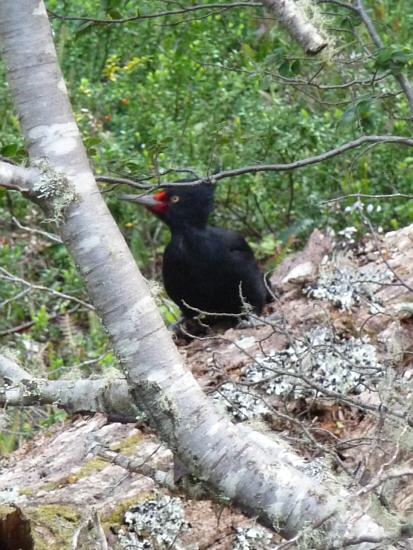 Through the park leads hiking trails on which one can discover glaciers, deep valleys and gorges and rivers and lakes.
However, we made a hike along the Beagle Channel to Bay Lapataia.
First, I thought there is nothing to see but trees (three types of South Beeches), the channel and the mountains.
But as I looked further I discovered a lot more.
On the water travelled a couple of flightless Steamer-Ducks (photo left) and on a tree near the hammered female Magellanic Woodpecker (photo right).
The male has a completely red head.
Through the park leads hiking trails on which one can discover glaciers, deep valleys and gorges and rivers and lakes.
However, we made a hike along the Beagle Channel to Bay Lapataia.
First, I thought there is nothing to see but trees (three types of South Beeches), the channel and the mountains.
But as I looked further I discovered a lot more.
On the water travelled a couple of flightless Steamer-Ducks (photo left) and on a tree near the hammered female Magellanic Woodpecker (photo right).
The male has a completely red head.
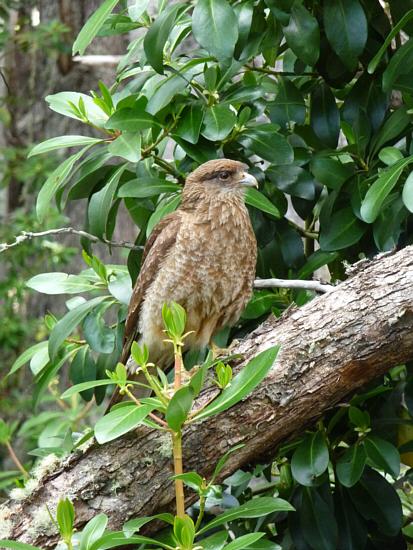
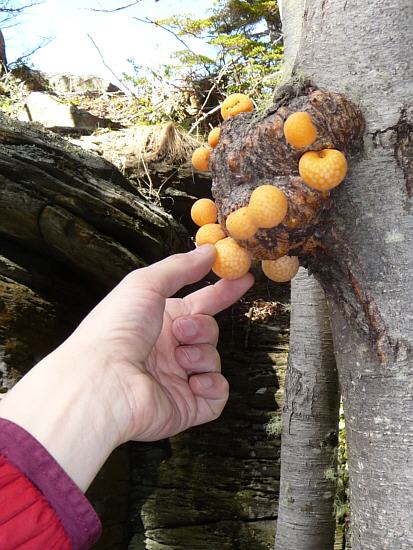 Many birds were to discover in the dense forests only for a limited time.
A few meters away from the way remains sitting a Cinerous Harrier (photo left) long enough to take a photo.
Orange balls grow on the trees (photo right), which our accompanying guide called as Indian Bread Guide.
The gummy fruits taste actually after nothing (tested), but fill the abdomen and contain much water.
By earlier the here still living Indians were eaten it, but today cost of tourists like me.
Many birds were to discover in the dense forests only for a limited time.
A few meters away from the way remains sitting a Cinerous Harrier (photo left) long enough to take a photo.
Orange balls grow on the trees (photo right), which our accompanying guide called as Indian Bread Guide.
The gummy fruits taste actually after nothing (tested), but fill the abdomen and contain much water.
By earlier the here still living Indians were eaten it, but today cost of tourists like me.
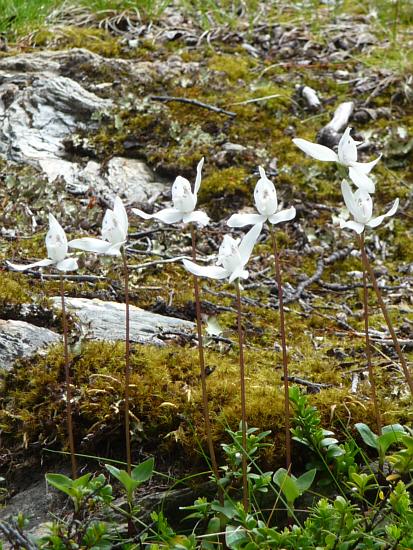
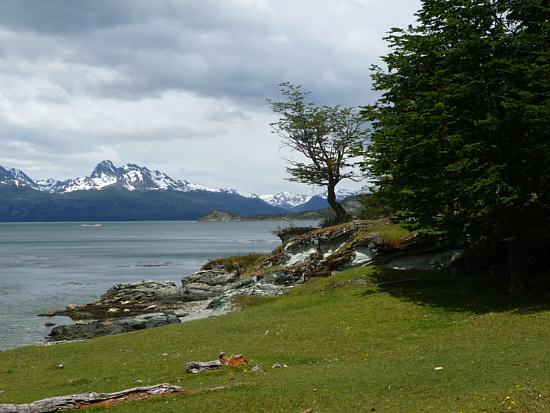 But do not see only upward and into the distance, otherwise you will inevitably tumble to a root or stone or jumping in a mud hole.
At your feet you will discover many beauties.
I be in evidence especially plants with white flowers, which closer turn out as White Orchids (photo left).
The flora and fauna is very rich, although the climatic summer is relatively short and the climate is already quite rough.
Lovers of plants and animals will have their real pleasure there.
But do not see only upward and into the distance, otherwise you will inevitably tumble to a root or stone or jumping in a mud hole.
At your feet you will discover many beauties.
I be in evidence especially plants with white flowers, which closer turn out as White Orchids (photo left).
The flora and fauna is very rich, although the climatic summer is relatively short and the climate is already quite rough.
Lovers of plants and animals will have their real pleasure there.
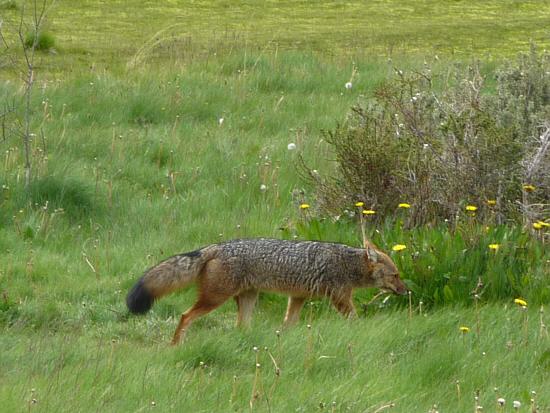
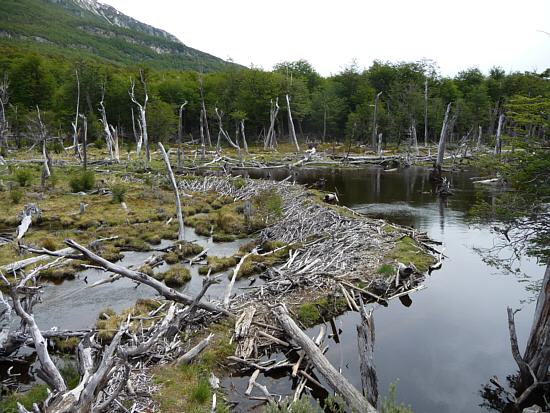 At the car park on Lapataia Bay an Culpeo Fox (photo left) ran about the way.
On the way back to Ushuaia we thought on an old beaver's lodge (photo right).
The old beaver disappeared for a year so the lodge slowly crumbles.
Is still a good picture of what caused damage by animals, which here introduced from North America.
Only in a few decades the nature initiative have replaces again gnawed off or flooded trees with small trees and shrubs.
At the car park on Lapataia Bay an Culpeo Fox (photo left) ran about the way.
On the way back to Ushuaia we thought on an old beaver's lodge (photo right).
The old beaver disappeared for a year so the lodge slowly crumbles.
Is still a good picture of what caused damage by animals, which here introduced from North America.
Only in a few decades the nature initiative have replaces again gnawed off or flooded trees with small trees and shrubs.
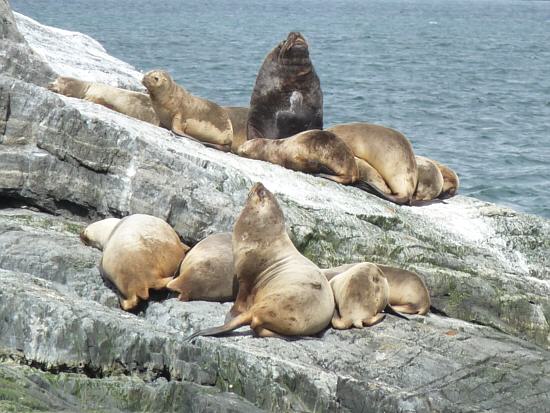
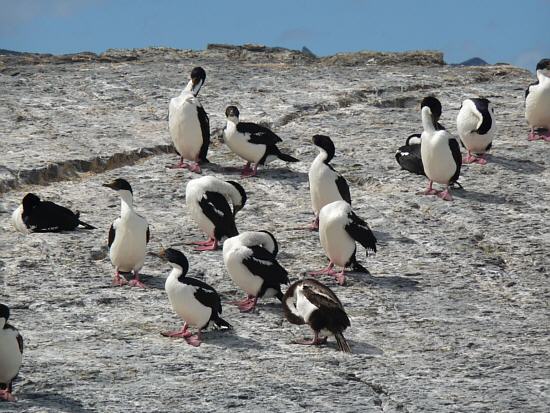 Ushuaia at the Beagle Channel is like Punta Arenas starting point of many expeditions to the Antarctic.
The channel moved us at the day 4 not so far, but only about a trip with a catamaran on the eastern part of the channel.
After a quite short time one can identify the first Sea Lions (photo left) and King Cormorants (photo right).
Ushuaia at the Beagle Channel is like Punta Arenas starting point of many expeditions to the Antarctic.
The channel moved us at the day 4 not so far, but only about a trip with a catamaran on the eastern part of the channel.
After a quite short time one can identify the first Sea Lions (photo left) and King Cormorants (photo right).
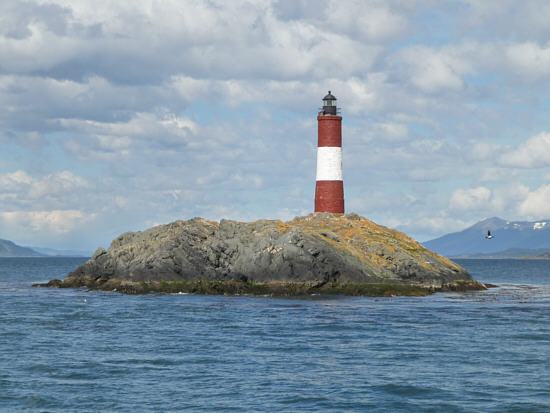
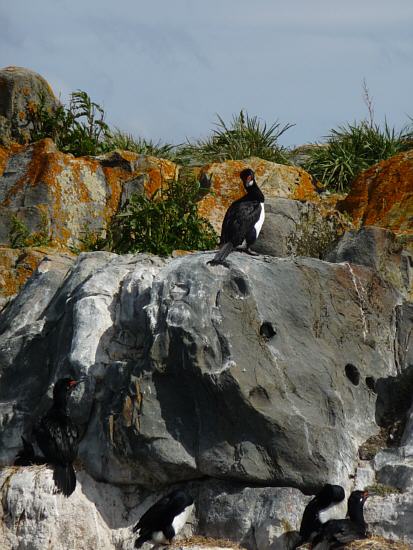 In the Beagle Channel are located the comprehensive group of 5 islands named Les Eclaireurs.
On one island there is the probable most photographed lighthouse of South America (photo left): Lighthouse Les Eclaireus (ARLHS ARG-016).
In the Beagle Channel are located the comprehensive group of 5 islands named Les Eclaireurs.
On one island there is the probable most photographed lighthouse of South America (photo left): Lighthouse Les Eclaireus (ARLHS ARG-016).
Somewhat further, were to see on a rocky island Rock Cormorants (photo right) with the characteristic red facial skin around the eyes.
The catamaran was moving very close to the island, but the animals did not interfere.
Many of the ships gone with us for a drive already huled off at this point and drove back to Ushuaia.
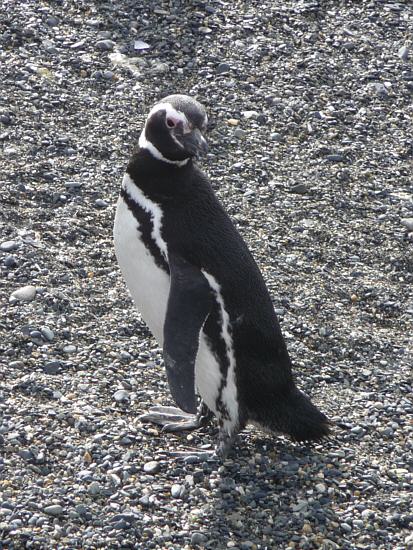
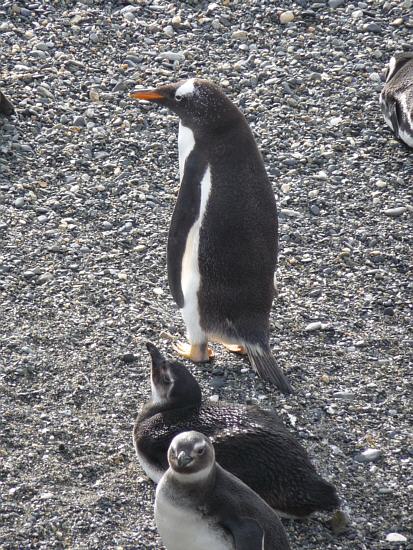 For us it goes continued a great way.
Behind the Gable Island there is a fairly large penguin colony on a smaller island.
Consists mainly of Magellanic Penguins (photo left).
Also a few Gentoo Penguin (photo right) can be found below.
Both types are approximately equal.
The Magellanic Penguins have a white feather strip, which goes out by an eye than in front on neck along to the other eye.
Gentoo Penguins have this connection directly through the head.
Also at least called ones have an orange beak and just as much feet, which quickly distinguish them.
For us it goes continued a great way.
Behind the Gable Island there is a fairly large penguin colony on a smaller island.
Consists mainly of Magellanic Penguins (photo left).
Also a few Gentoo Penguin (photo right) can be found below.
Both types are approximately equal.
The Magellanic Penguins have a white feather strip, which goes out by an eye than in front on neck along to the other eye.
Gentoo Penguins have this connection directly through the head.
Also at least called ones have an orange beak and just as much feet, which quickly distinguish them.
Also during my stay in Ushuaia I heard nothing from my antenna pole.
Because my knowledge of Spanish is very modest, our guide Roland Kordy phoned on my request again at the airport in Buenos Aires.
He agreed that the pole at least should be back in the hotel in Buenos Aires before my return flight.
The missing pole would not so bad, if there would be at least enough high trees in this region.
But the existing varieties are only about 4 m high and are therefore only a little value as anchoring points for the antenna wire.
No good prerequisites for successful radio operation, especially if activity of the sun is very low.
On the way 
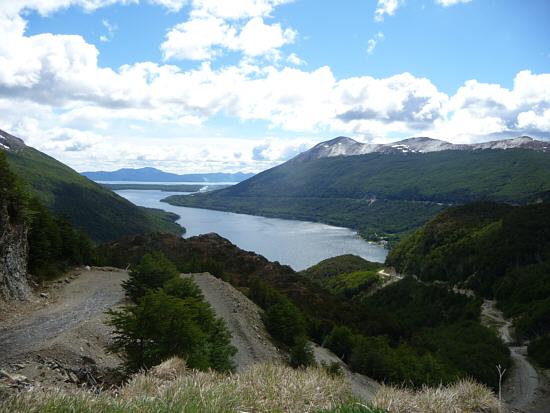
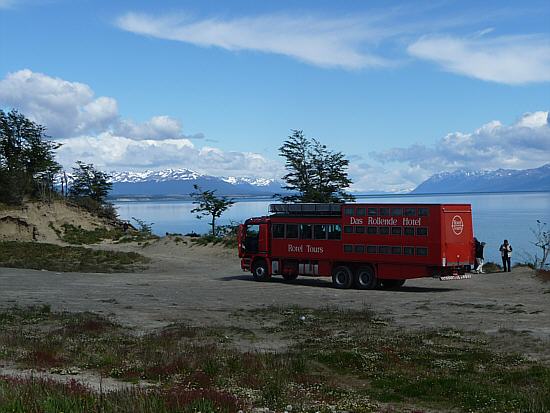 At the day 5 we left Ushuaia towards San Sebastian.
The Garibaldi Pass allows a wide view ahead the landscape and embedded lakes.
In the foreground was the Lagoon Escondida zu discover (photo left).
Along we achieved the Lake Fagnano, which trench almost the entire Tierra del Fuego and which was to detect from the pass in the distance (photo right).
Led our way initially by the mountains, the area was quickly planer and treelesser.
At the day 5 we left Ushuaia towards San Sebastian.
The Garibaldi Pass allows a wide view ahead the landscape and embedded lakes.
In the foreground was the Lagoon Escondida zu discover (photo left).
Along we achieved the Lake Fagnano, which trench almost the entire Tierra del Fuego and which was to detect from the pass in the distance (photo right).
Led our way initially by the mountains, the area was quickly planer and treelesser.
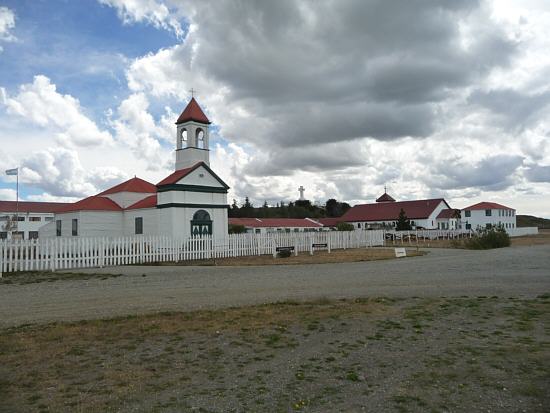
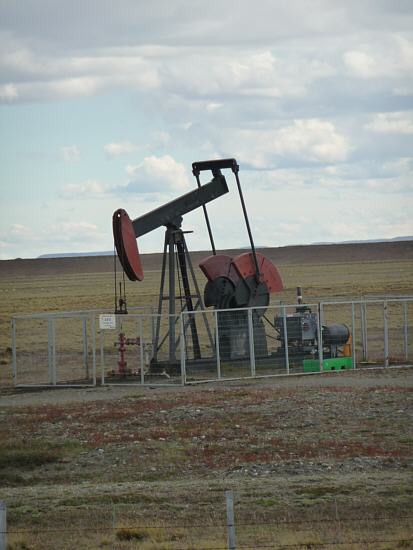 Near Rio Grande is a mission of the Salesians (photo left).
An informative exhibition of the life of the now extinct Indian exists in one of the buildings.
Also the same house presents on the floor the domestic animals.
The latter is particularly worth a visit, because one can to even consider the otherwise only briefly to see birds and animals in rest.
Oh yes, Argentina has its own oil resources.
The occasionally to see horse-head pumps reports by that (photo right).
But the hauling quantity is not even enough to meet the requirement in their own country.
Near Rio Grande is a mission of the Salesians (photo left).
An informative exhibition of the life of the now extinct Indian exists in one of the buildings.
Also the same house presents on the floor the domestic animals.
The latter is particularly worth a visit, because one can to even consider the otherwise only briefly to see birds and animals in rest.
Oh yes, Argentina has its own oil resources.
The occasionally to see horse-head pumps reports by that (photo right).
But the hauling quantity is not even enough to meet the requirement in their own country.
Before we could get our quarter in the evening, a border had to be passed.
There are actually already two of them.
The Argentine border requires time.
The no man's land following the Chilean checkpoint tens of kilometres.
Because the Chileans takes very care and no fresh food (fruits, vegetables, meat) reach in the country, we had to build our housing once and seaching the housing and explore the bags.
Just behind the border we spent the night on an sheep farm.
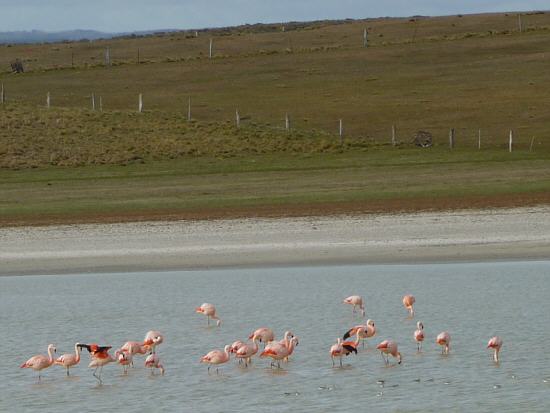
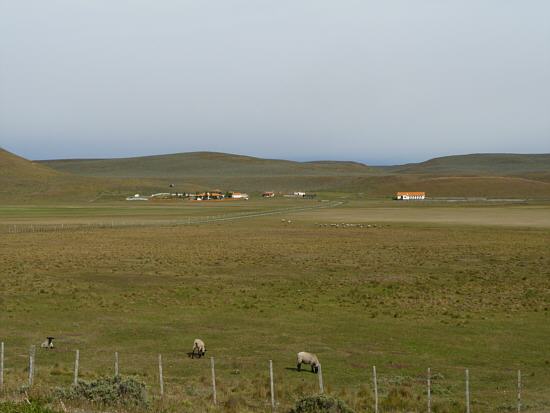 At the day 6 we left San Sebastion in North.
Near the way we could identify flamingos (photo left).
It's do not nest here although, but like to leverage the rich food offerings throughout the year.
Time and again brought me to the wonder the vast amounts of land belonging to a single sheep farm here.
Often one can from the main road only see the roads to them, but not the houses.
The houses are often tens of kilometres far away, although the property begins at the main street (photo right).
At the day 6 we left San Sebastion in North.
Near the way we could identify flamingos (photo left).
It's do not nest here although, but like to leverage the rich food offerings throughout the year.
Time and again brought me to the wonder the vast amounts of land belonging to a single sheep farm here.
Often one can from the main road only see the roads to them, but not the houses.
The houses are often tens of kilometres far away, although the property begins at the main street (photo right).
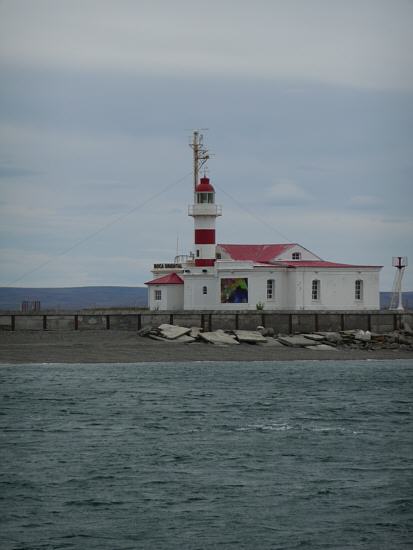
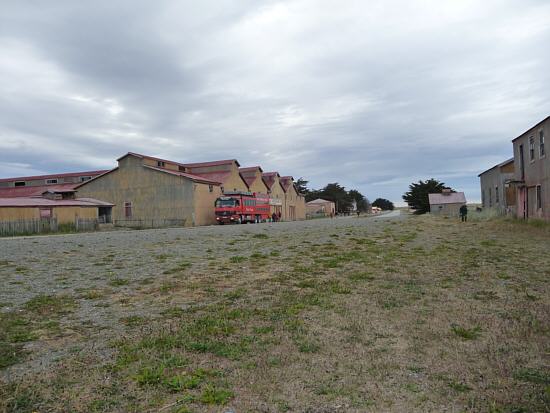 The passage from the island Tierra del Fuego Island to the mainland of Patagonia went smoothly since the Magellan Strait was quiet.
The Lighthouse Punta Deldada (ARLHS CHI-015) signals the eastern entrance to the Magellan Strait (photo left).
We drove more or less far away from this waterway by almost treeless and deserted areas.
One sheep farm was rarely see.
The sheep farm San Gregorio (photo right) directly on the main road was a lively village in the heyday of sheep farming determined times.
Today most of the buildings are apparently unused.
The passage from the island Tierra del Fuego Island to the mainland of Patagonia went smoothly since the Magellan Strait was quiet.
The Lighthouse Punta Deldada (ARLHS CHI-015) signals the eastern entrance to the Magellan Strait (photo left).
We drove more or less far away from this waterway by almost treeless and deserted areas.
One sheep farm was rarely see.
The sheep farm San Gregorio (photo right) directly on the main road was a lively village in the heyday of sheep farming determined times.
Today most of the buildings are apparently unused.
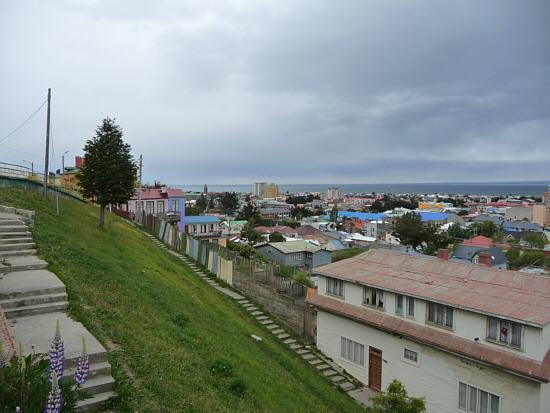
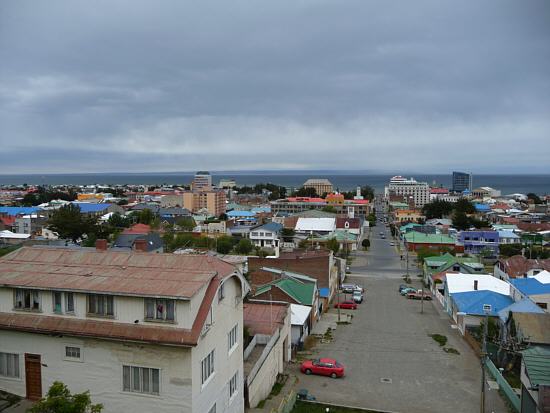 Target at the evening was Punta Arenas.
This is already a big city with more than 100000 inhabitants, but it has retained the charm of an old seaport (photo left).
This time we do not sleep in the bus, but in a hostel.
Incidentally, this is a good alternative for those visitors that go on their own across the land and want not to stay in a hotel.
These hostels can be found everywhere in large numbers.
Target at the evening was Punta Arenas.
This is already a big city with more than 100000 inhabitants, but it has retained the charm of an old seaport (photo left).
This time we do not sleep in the bus, but in a hostel.
Incidentally, this is a good alternative for those visitors that go on their own across the land and want not to stay in a hotel.
These hostels can be found everywhere in large numbers.
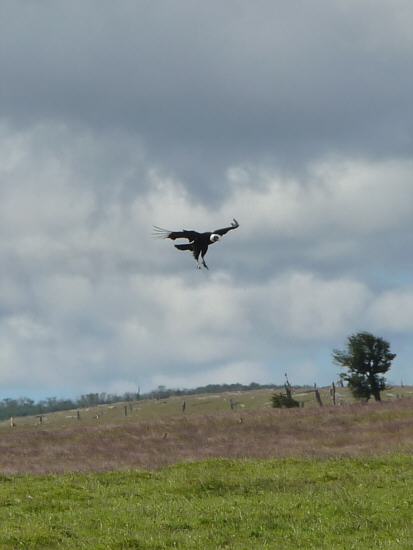
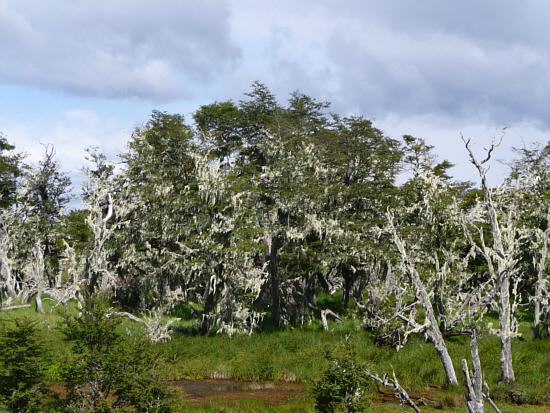 The next day, the day 7 of our travel led us further north.
The first appearance, the environment becomes less varied.
But watch out exactly.
Once several Andean Condors was during our journey to spy by their lunch near the road.
They did not disturb by us.
A step tuther were trees to see were almost entirely with lichens.
You will find this fairytale forests, particularly in those places in the country where it is slightly dampier.
The next day, the day 7 of our travel led us further north.
The first appearance, the environment becomes less varied.
But watch out exactly.
Once several Andean Condors was during our journey to spy by their lunch near the road.
They did not disturb by us.
A step tuther were trees to see were almost entirely with lichens.
You will find this fairytale forests, particularly in those places in the country where it is slightly dampier.
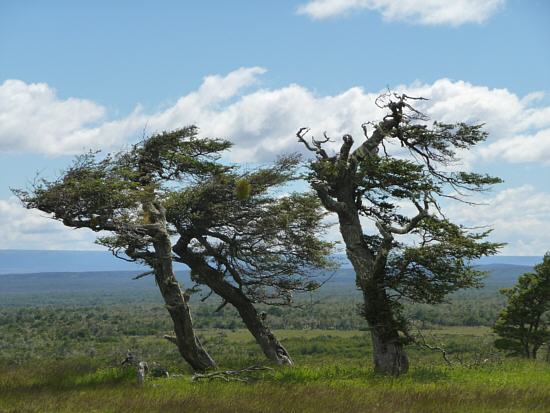
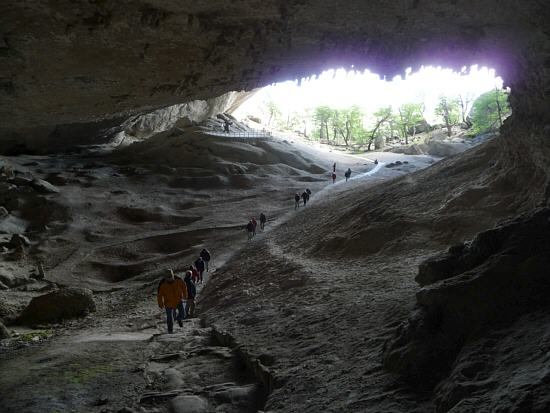 It is always difficult to capture the climate on photos.
But see you once the trees.
The wind always fluttering shapes everything, facing it in the way (photo left).
After a break in the city of Puerto Natales we contributed a Cave of the Milodón (photo right).
Researchers found in this cave many years ago bones and fure remains of an until then unknown animal, which lifed there after the last ice age.
Today the remains of the herbivorous 3 m large sloth are located in London.
It is always difficult to capture the climate on photos.
But see you once the trees.
The wind always fluttering shapes everything, facing it in the way (photo left).
After a break in the city of Puerto Natales we contributed a Cave of the Milodón (photo right).
Researchers found in this cave many years ago bones and fure remains of an until then unknown animal, which lifed there after the last ice age.
Today the remains of the herbivorous 3 m large sloth are located in London.
The mountains 
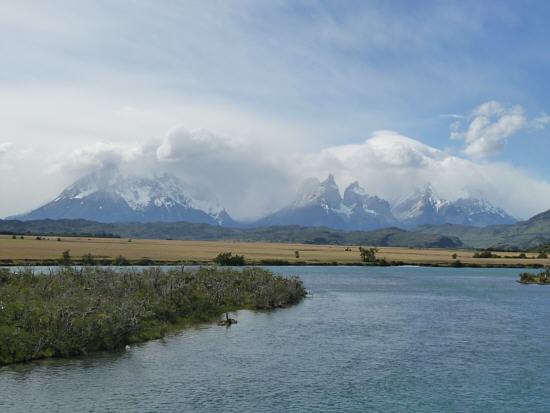
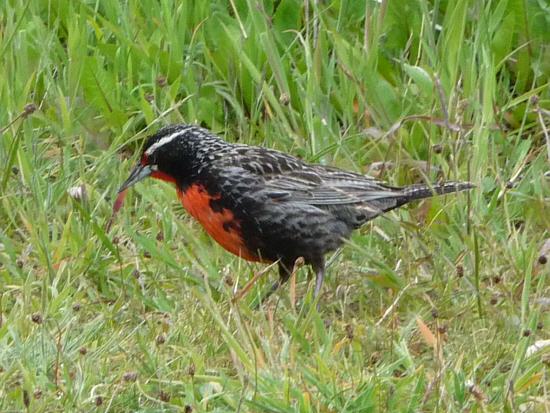 In the evening we arrived in the National Park of Torres del Paine.
Its famous mountains were almost completely hidden in the clouds, but could detect already from the entrance to the park.
But various birds at the campsite on the Lake Pehoé one could see despite the light rain.
In the evening we arrived in the National Park of Torres del Paine.
Its famous mountains were almost completely hidden in the clouds, but could detect already from the entrance to the park.
But various birds at the campsite on the Lake Pehoé one could see despite the light rain.
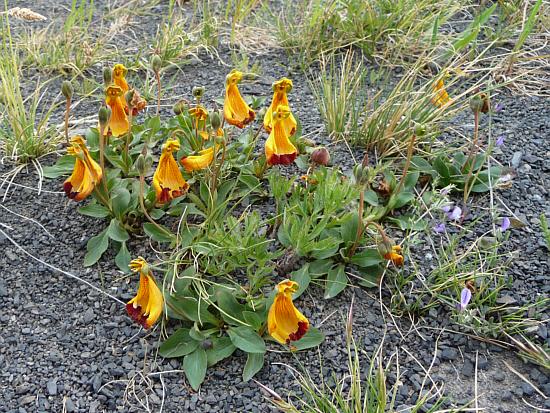
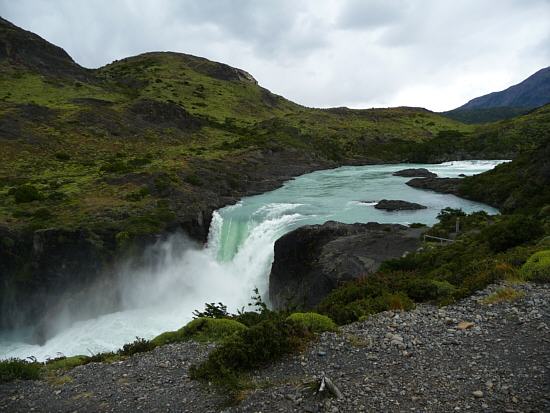 During the two hikes at day 8 the weather however slightly improved.
In the morning we walked to the Viewpoint Cuernos, where we hoped to see the bicoloured mountains immediately ahead.
The way led past the large waterfall (photo right).
I am once again surprised by the species variety of flowers, shrubs and trees in this harsh climate (photo left).
I have it happened almost any plant wants to make up the missing size by a special flower.
During the two hikes at day 8 the weather however slightly improved.
In the morning we walked to the Viewpoint Cuernos, where we hoped to see the bicoloured mountains immediately ahead.
The way led past the large waterfall (photo right).
I am once again surprised by the species variety of flowers, shrubs and trees in this harsh climate (photo left).
I have it happened almost any plant wants to make up the missing size by a special flower.
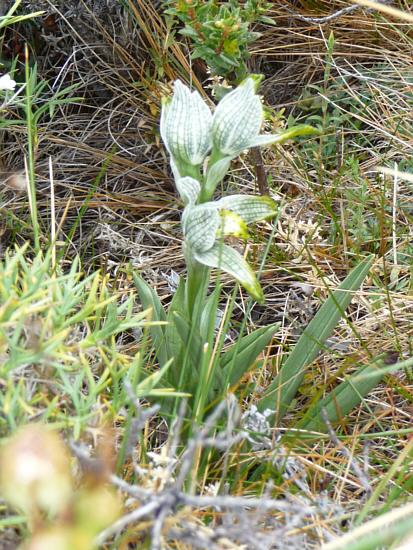
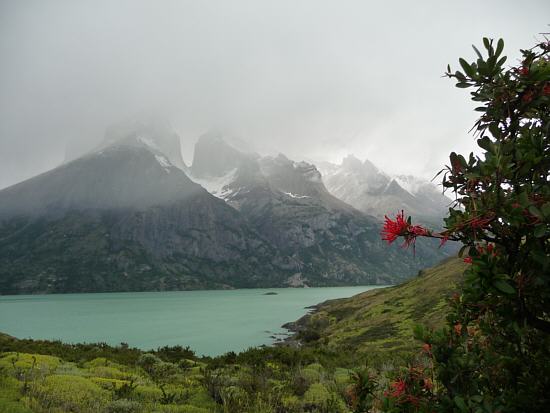 Various birds live between and in the bushes and trees.
Also orchids grow there (photo left).
Overall, there should be seven orchids in the national park.
After a short hour we reached the viewpoint.
But now directly ahead the Cuernos summits remained hidden with heads in the clouds.
On the way back, always something new was to see what had not seen for the first time.
Think so always open the eyes.
Various birds live between and in the bushes and trees.
Also orchids grow there (photo left).
Overall, there should be seven orchids in the national park.
After a short hour we reached the viewpoint.
But now directly ahead the Cuernos summits remained hidden with heads in the clouds.
On the way back, always something new was to see what had not seen for the first time.
Think so always open the eyes.
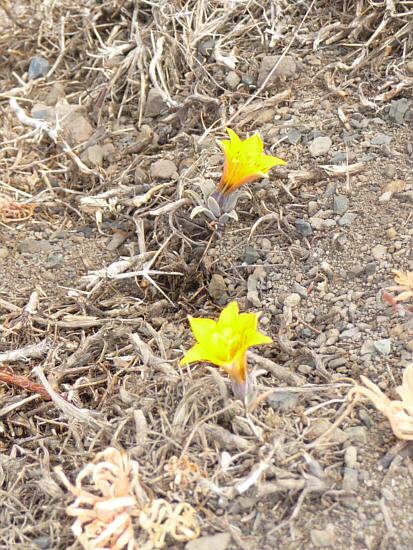
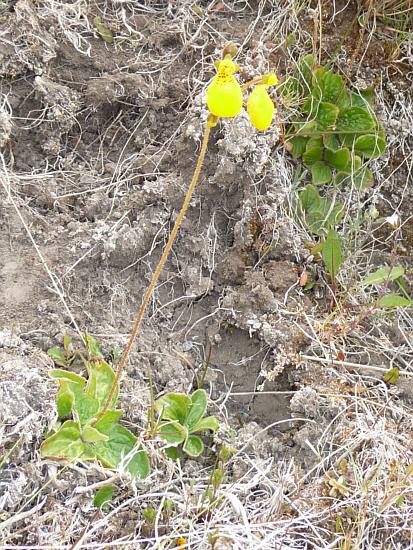 The entranceway Laguna Amarga and Samiento are located on the western border of the national park.
There is a trail between them, which our guide Roland presented us as guanaco trail.
Starts with new plants were to see a swarm of 18 (!) Andean Condors surprised us suddenly, consisted of young and adult birds.
The Condors in the air moved slowly quite low on our small group.
Had one of them selected the last one of our group as lunch?
But don't worry: Condors eat only carrion - usually.
The entranceway Laguna Amarga and Samiento are located on the western border of the national park.
There is a trail between them, which our guide Roland presented us as guanaco trail.
Starts with new plants were to see a swarm of 18 (!) Andean Condors surprised us suddenly, consisted of young and adult birds.
The Condors in the air moved slowly quite low on our small group.
Had one of them selected the last one of our group as lunch?
But don't worry: Condors eat only carrion - usually.
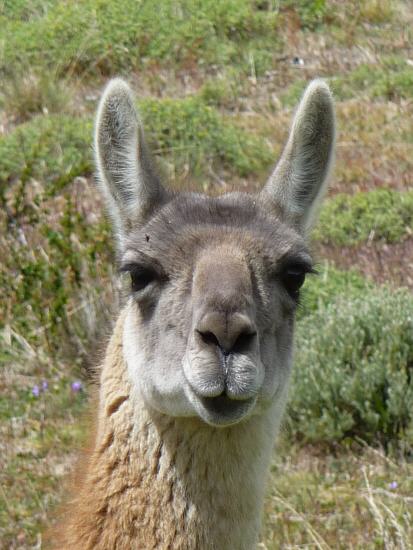
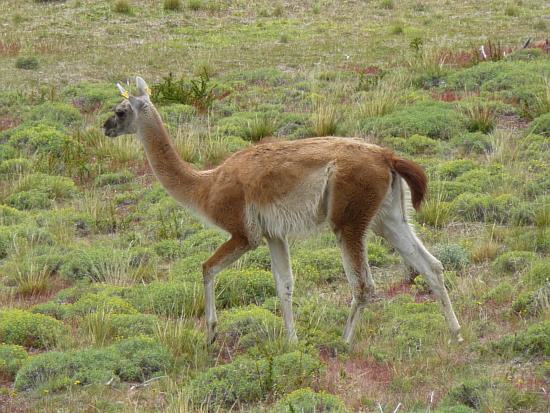 And then we met the main attraction on this way: the Guanacos.
First were to identify only individual animals with their kids.
Later, more and more groups followed until we finally found a herd of over 70 animals.
In the previously travelled through parts of Patagonia we can get only Guanaco asses to photograph, also if we cautious approached.
The Guanacos remain completely quiet in the park despite approching people.
There are even able to approach them up to a few meters.
But not exaggerate!
They descended from the lamas and can spit as accurately.
As long as you can see their ears like on the photo left all is square.
Apart from that reverse.
And then we met the main attraction on this way: the Guanacos.
First were to identify only individual animals with their kids.
Later, more and more groups followed until we finally found a herd of over 70 animals.
In the previously travelled through parts of Patagonia we can get only Guanaco asses to photograph, also if we cautious approached.
The Guanacos remain completely quiet in the park despite approching people.
There are even able to approach them up to a few meters.
But not exaggerate!
They descended from the lamas and can spit as accurately.
As long as you can see their ears like on the photo left all is square.
Apart from that reverse.
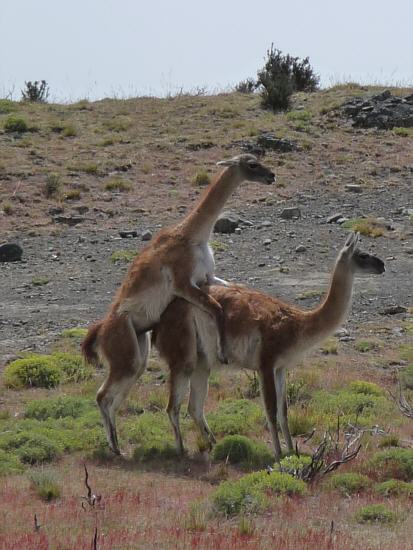
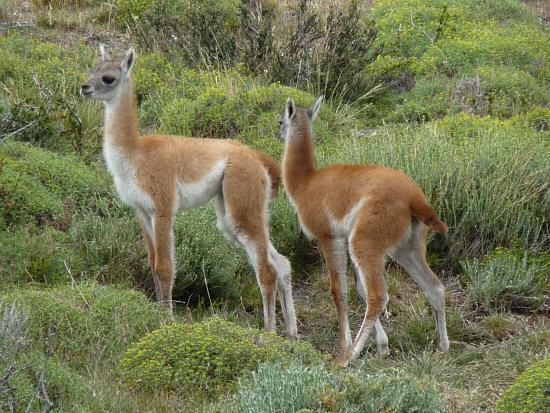 Disputes among themselves bear the Guanacos likely from to time with a wild race.
The goal is to bite the opponent in the legs.
And the animal don't stop before a human.
So it happened two Guanacos in the full galopp ran across the group.
If one should stand them in the way, they push him otherwise with attracted forefeets simply away.
And that would be very achingly.
The fence of the park represents no obstacle for them.
The fence is intended only for outside living sheeps.
Disputes among themselves bear the Guanacos likely from to time with a wild race.
The goal is to bite the opponent in the legs.
And the animal don't stop before a human.
So it happened two Guanacos in the full galopp ran across the group.
If one should stand them in the way, they push him otherwise with attracted forefeets simply away.
And that would be very achingly.
The fence of the park represents no obstacle for them.
The fence is intended only for outside living sheeps.
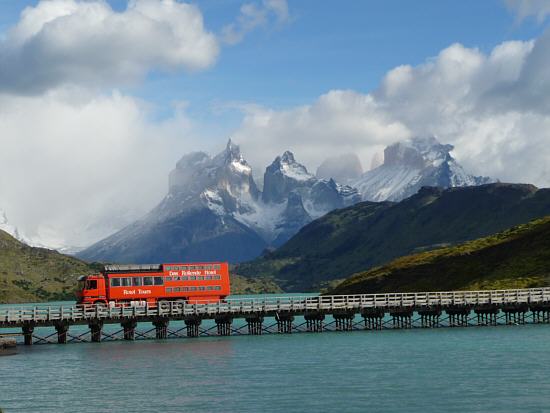
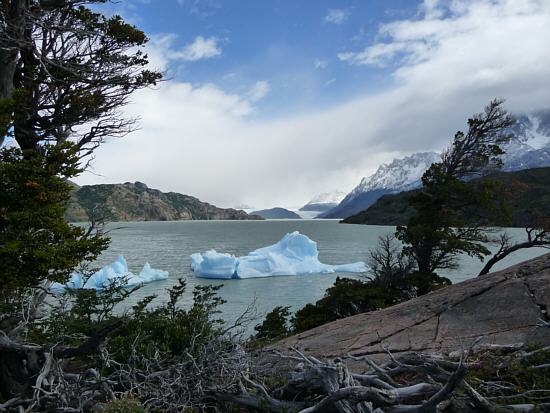 At breakfast of the day 9 those members of our group, who had risen early (so at 5 o′clock) reported that the two Cuernos was freely and also appeared in the red light.
I do not belonged to the early birds, so that the mountains were again somewhat covered.
Goal of the day was the Lake Grey with the same name glacier.
It is possible to drive with a ship to the glacier.
We however remained at the southern end of the lake and made a hike on the peninsula.
From it you have a magnificent view of the large lake with the glacier in the background.
And since the weather was always better, there was to see enough of them.
At breakfast of the day 9 those members of our group, who had risen early (so at 5 o′clock) reported that the two Cuernos was freely and also appeared in the red light.
I do not belonged to the early birds, so that the mountains were again somewhat covered.
Goal of the day was the Lake Grey with the same name glacier.
It is possible to drive with a ship to the glacier.
We however remained at the southern end of the lake and made a hike on the peninsula.
From it you have a magnificent view of the large lake with the glacier in the background.
And since the weather was always better, there was to see enough of them.
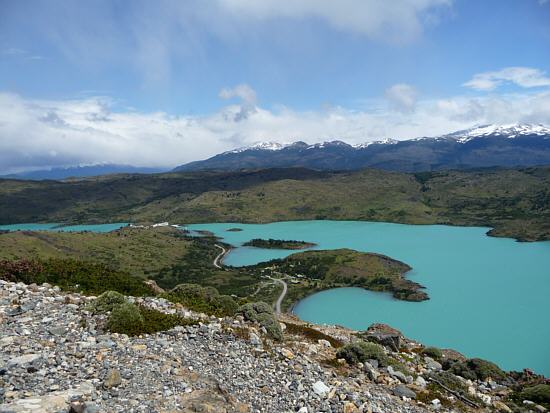
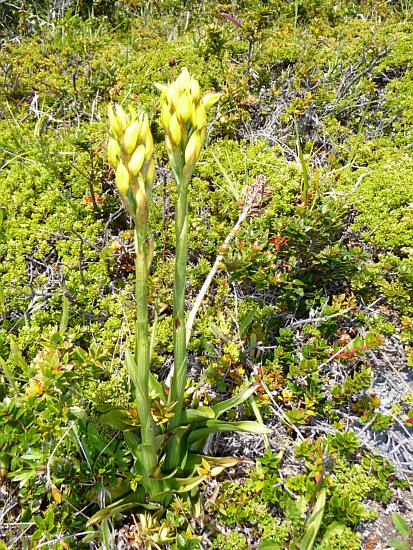 In the afternoon we were again at the campsite.
Therefore, the opportunity to rise to Viewpoint Condor offered for those who wanted something hiking.
The view from there above is excellent (photo left).
The trail passes South Beeches, rrchids (photo right), and various other plants.
But be careful! Although it is almost completely calm in the valley, a wind of not to underrating strength is up there.
It is therefore advisable only to climp up if is almost calm in the valley.
Otherwise you could not stand there above.
When an attempt it succeeded to me to slanted against the wind like a ski jumpers.
The summit is wide enough so that you can't blow down the cliffs.
In the afternoon we were again at the campsite.
Therefore, the opportunity to rise to Viewpoint Condor offered for those who wanted something hiking.
The view from there above is excellent (photo left).
The trail passes South Beeches, rrchids (photo right), and various other plants.
But be careful! Although it is almost completely calm in the valley, a wind of not to underrating strength is up there.
It is therefore advisable only to climp up if is almost calm in the valley.
Otherwise you could not stand there above.
When an attempt it succeeded to me to slanted against the wind like a ski jumpers.
The summit is wide enough so that you can't blow down the cliffs.
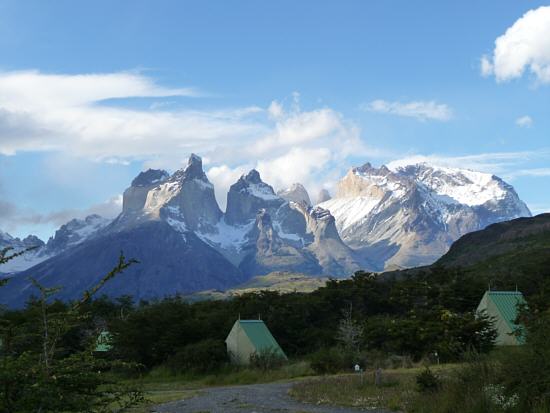
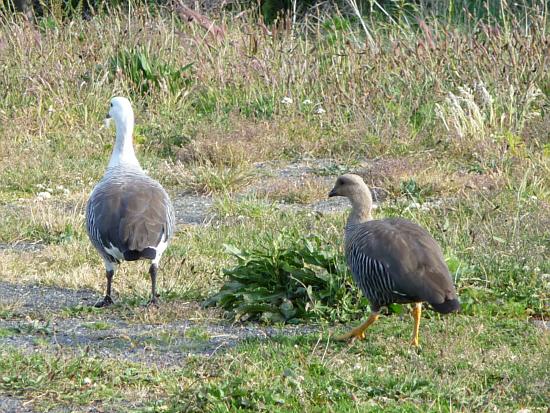 At the late evening the two Cuernos were even totally free to see (photo left).
The mountains have it's name from their composition of two rock layers, a bright layer and dark upper layer.
Through the work of the glacier, which covered these area during the last iceage this unique rock was rub down.
Not only at night at the campsite was Magellan Goose to see (photo right).
They live in almost all parts of Tierra del Fuego and Patagonia.
At the late evening the two Cuernos were even totally free to see (photo left).
The mountains have it's name from their composition of two rock layers, a bright layer and dark upper layer.
Through the work of the glacier, which covered these area during the last iceage this unique rock was rub down.
Not only at night at the campsite was Magellan Goose to see (photo right).
They live in almost all parts of Tierra del Fuego and Patagonia.
I built up my station during two nights in the national park.
In Ushuaia, I still had tried to buy a new pole.
But in a specialized dealer only fishing poles up 2 m were to buy.
I took with only some fishing line.
The small trees had to serve as the antenna wire anchoring points.
The success was not hot.
Although I could hear many stations (W3 W4, UA0, KH6, IK6...) loud, but the calls been unsuccessfully.
And yet fair stations from Argentina and Chile always calling for DX, what I respected.
Again on the way 
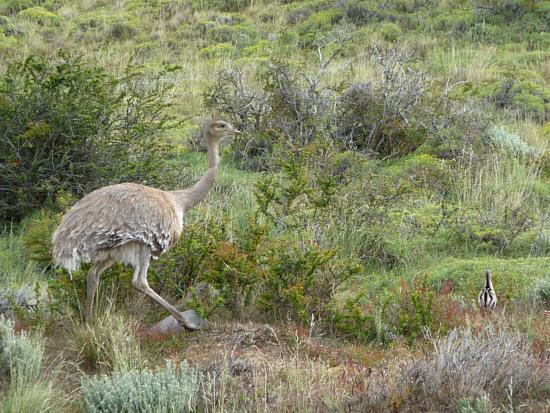
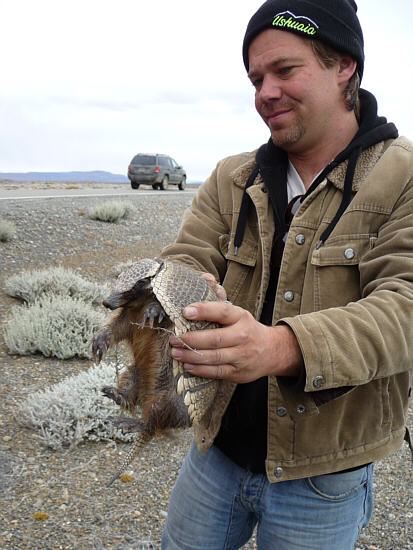 At the day 10 it goes to the glaciers.
There is also glaciers inside the just exited national park, but not so readily accessible and not in such large numbers.
Not only it is worth to take a longer journey again.
As always you should keep open the eyes here.
Thus were occasionally to see Darwin Rhea.
They are always on the run.
During this run the male runs in a direction and its fledglings in the other one.
But once it was me once possible to get both simultaneously on the photo (photo left).
After a fast braking, Roland attacked an Armadillo, which crossed the street and now wanted to hide behind a small shrub.
It looked like a knight with its thick carapace.
After Roland again unclapsed the animal, it ran away at an incredible pace with its short legs.
At the day 10 it goes to the glaciers.
There is also glaciers inside the just exited national park, but not so readily accessible and not in such large numbers.
Not only it is worth to take a longer journey again.
As always you should keep open the eyes here.
Thus were occasionally to see Darwin Rhea.
They are always on the run.
During this run the male runs in a direction and its fledglings in the other one.
But once it was me once possible to get both simultaneously on the photo (photo left).
After a fast braking, Roland attacked an Armadillo, which crossed the street and now wanted to hide behind a small shrub.
It looked like a knight with its thick carapace.
After Roland again unclapsed the animal, it ran away at an incredible pace with its short legs.
Somewhat slower it went go at the border crossing.
The procedure was the same.
This time we had not to build our housing and to open our bags.
The glaciers 
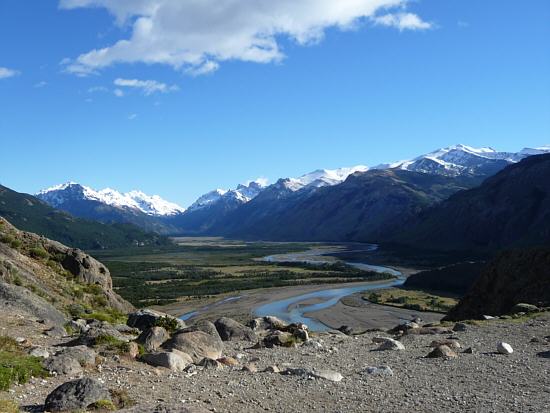
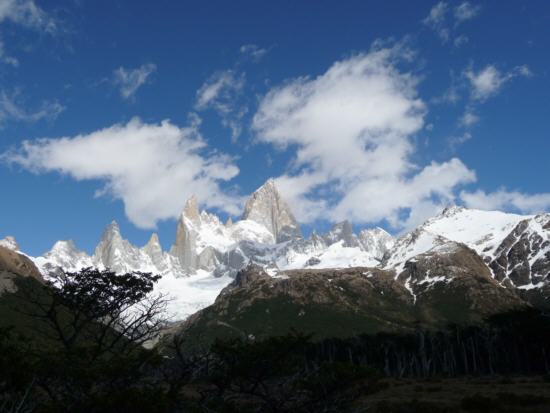 The day 11 led us closer to the northern part of ice massif.
Many hiking trails go from El Chaltén.
Christoph, a fellow passenger, and I chose a longer route at the evening before, led by the two main valleys in this area.
With the rise in a valley (photo left) I heard at once wild birdcalls.
First I do not believe my ears because I knew such cries from much warmer areas.
But then I spotted it: a swarm of Austral Parakeets.
But they quickly disappeared again in the forest thicket.
After some hours throug woods with South Beehes and across meadows, we reached our first goal: the Cerro Fitz Roy (photo right).
He rises to almost perpendicular from the mountains.
The day 11 led us closer to the northern part of ice massif.
Many hiking trails go from El Chaltén.
Christoph, a fellow passenger, and I chose a longer route at the evening before, led by the two main valleys in this area.
With the rise in a valley (photo left) I heard at once wild birdcalls.
First I do not believe my ears because I knew such cries from much warmer areas.
But then I spotted it: a swarm of Austral Parakeets.
But they quickly disappeared again in the forest thicket.
After some hours throug woods with South Beehes and across meadows, we reached our first goal: the Cerro Fitz Roy (photo right).
He rises to almost perpendicular from the mountains.
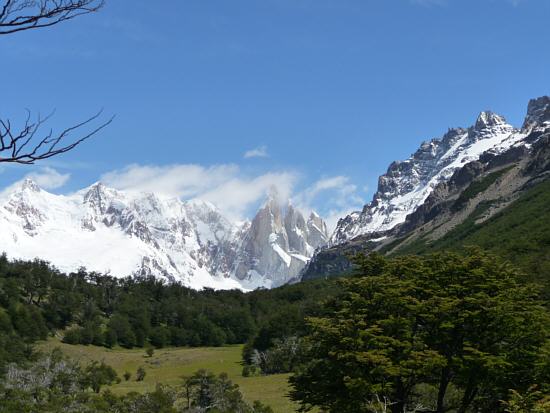
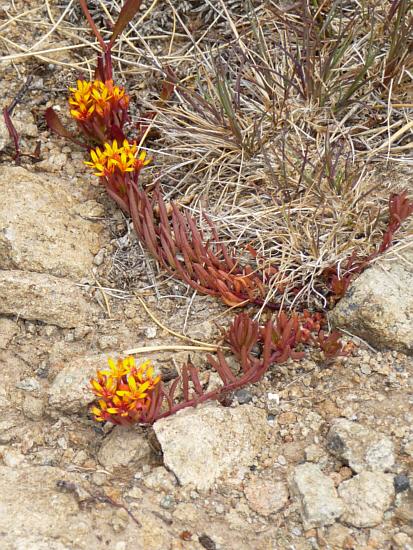 Leading through a small mountain ridge the way led us to the second valley.
In this valley one can see the no less striking Cerro Torre closer.
Opposite the Cerro Fitz Roy it is still thinner and appears thus sharper.
Snow can keep themselves hardly at its summit.
The clouds stuck up there.
The descent went through dense shrubs and over free, rocky surfaces.
On this surface I discovered a for me until then unknown plant.
Amazingly where is everywhere life suggests, if water and light are present.
Leading through a small mountain ridge the way led us to the second valley.
In this valley one can see the no less striking Cerro Torre closer.
Opposite the Cerro Fitz Roy it is still thinner and appears thus sharper.
Snow can keep themselves hardly at its summit.
The clouds stuck up there.
The descent went through dense shrubs and over free, rocky surfaces.
On this surface I discovered a for me until then unknown plant.
Amazingly where is everywhere life suggests, if water and light are present.
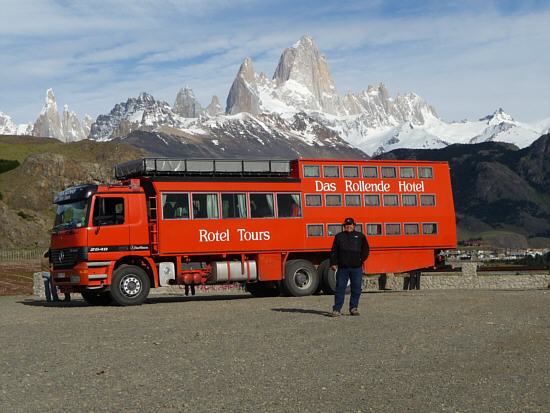
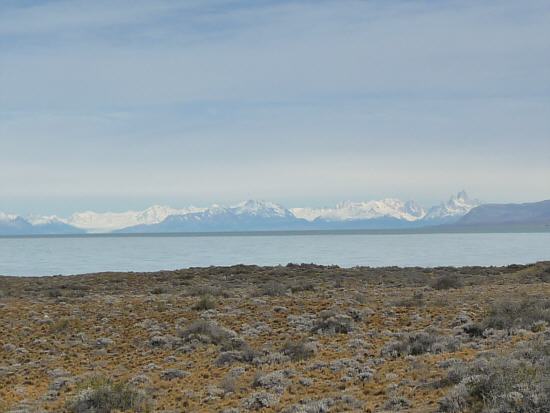 On our departure from El Chaltén on the day 12 the mountains showed again at its best.
This was a welcome opportunity to take a last picture at the entrance to the village - of course with bus and the driver Markus Wölfl.
Then it went the road again a piece southward to El Calafate.
Overlooking the Viedma Lake to the glacier of same name 80 km away and the mountains near El Chaltén correct me the size of the Andes deliberately.
On our departure from El Chaltén on the day 12 the mountains showed again at its best.
This was a welcome opportunity to take a last picture at the entrance to the village - of course with bus and the driver Markus Wölfl.
Then it went the road again a piece southward to El Calafate.
Overlooking the Viedma Lake to the glacier of same name 80 km away and the mountains near El Chaltén correct me the size of the Andes deliberately.
The next two days were fully devoted to the glaciers.
These tongues of ice found along the 400 km long and in some places 70 km wide area of never melting off ice, the Campo de Hielo Patagonico sur.
It is the third largest contiguous ice area in the world after Antarctica and Greenland.
And it is possible during the ice production year-round, it is understandable that every so often somewhat slight above the rim (for example over the surrounding mountains).
Unfortunately the card in my camera was no longer to read in Buenos Aires.
That's why this two days an the glaciers were lost at least as photos.
So the next four pictures are taken by Christoph.
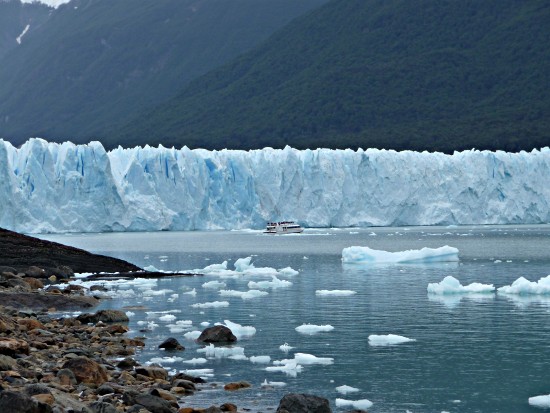
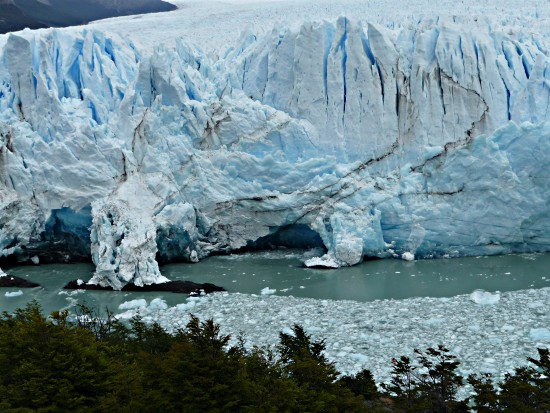 One of the most known glacier is the Perito Moreno Glacier, which we could admire from nearby at the day 13.
It occasionally goes over the Tempanos Channel to a head.
At the right and at the left are located ice walls, at which cut off huge ice chunk with loud noise and clap in the water - a spectacle, you can watch for hours.
There are huge ice clefts on the surface of the glacier.
One of the most known glacier is the Perito Moreno Glacier, which we could admire from nearby at the day 13.
It occasionally goes over the Tempanos Channel to a head.
At the right and at the left are located ice walls, at which cut off huge ice chunk with loud noise and clap in the water - a spectacle, you can watch for hours.
There are huge ice clefts on the surface of the glacier.
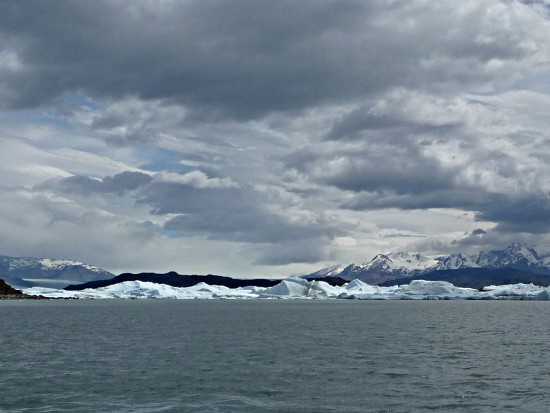 The next day, the day 14 of the journey, it went from the 50 km away port Puerto Bandera with a catamaran on the Lake Argentino and the glaciers contrary.
Unfortunately the Onelli Bay was "clogged" by the many icebergs of the Onelli Glaciers and there was no way to get through.
But the huge in water swimming ice pieces were very respectable.
They glimmer as the glaciers on the previous day in all shades of white on light blue up to deep blue.
The next day, the day 14 of the journey, it went from the 50 km away port Puerto Bandera with a catamaran on the Lake Argentino and the glaciers contrary.
Unfortunately the Onelli Bay was "clogged" by the many icebergs of the Onelli Glaciers and there was no way to get through.
But the huge in water swimming ice pieces were very respectable.
They glimmer as the glaciers on the previous day in all shades of white on light blue up to deep blue.
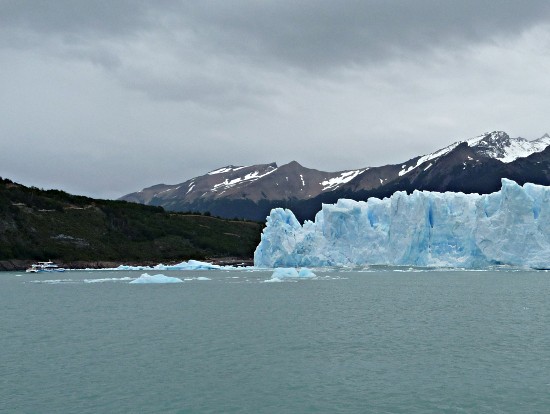 The captain ascended to drive as compensation for the non achieved Onelli Glacier to the south wall of the Perito Moreno Glacier.
On the day before we saw just before the ice wall crossing ships - and begrudged the passengers because they come closer at the wall.
But I can tell you that the experience from the is much prettier.
Although seen almost immediately wall of ice happening but the cuted of ice chunk looked sensationaler at the head.
Also the bang of breaking ice inside of the glacier was almost completely missing.
The captain ascended to drive as compensation for the non achieved Onelli Glacier to the south wall of the Perito Moreno Glacier.
On the day before we saw just before the ice wall crossing ships - and begrudged the passengers because they come closer at the wall.
But I can tell you that the experience from the is much prettier.
Although seen almost immediately wall of ice happening but the cuted of ice chunk looked sensationaler at the head.
Also the bang of breaking ice inside of the glacier was almost completely missing.
At noon of the day 15 we flew unfortunately once again returned to Buenos Aires.
Although I already all hope was let go, I asked at the hotel again after my antenna pole.
But nothing was found in the storeroom.
Elisabeth, our guide in Buenos Aires, agreed with the airport therefore, that the pole, which at once located in Ushuaia, should be sent me to Germany.
The address was already known to the people at the airport.
As a precaution I leave my phone number and email address.
Buenos Aires 
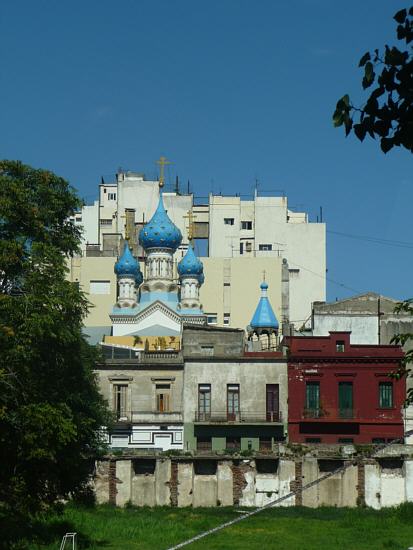
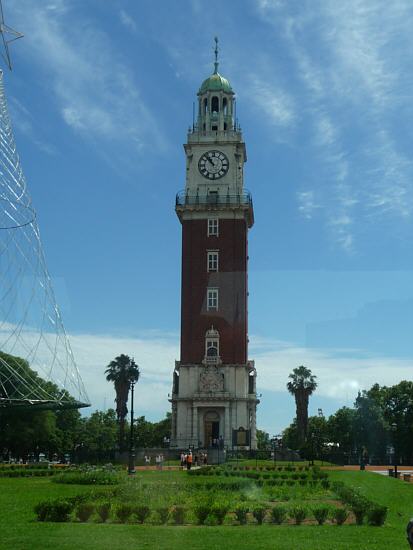 The morning of day 16 was filled with a city tour.
It went through an arts district, past the old and new ports and cross and cross through the old town.
13 million people live in Buenos Aires and the surrounding area.
Many of them are immigrants or descendants of them.
And so it's no surprise that they brought their religions. And between densely available flats for example an Orthodox Church was to discover.
At a birthday party of the city, many other cities brought with gifts.
This includes among other things also the English Bell Tower.
The morning of day 16 was filled with a city tour.
It went through an arts district, past the old and new ports and cross and cross through the old town.
13 million people live in Buenos Aires and the surrounding area.
Many of them are immigrants or descendants of them.
And so it's no surprise that they brought their religions. And between densely available flats for example an Orthodox Church was to discover.
At a birthday party of the city, many other cities brought with gifts.
This includes among other things also the English Bell Tower.
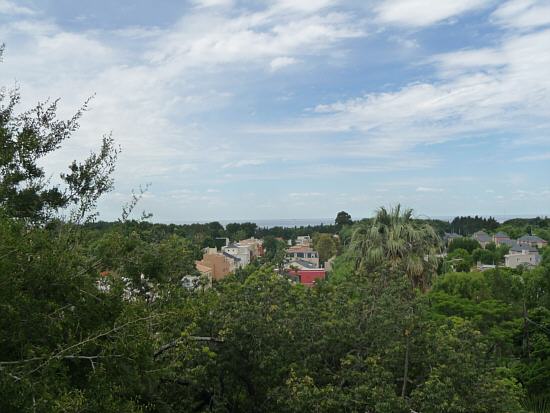
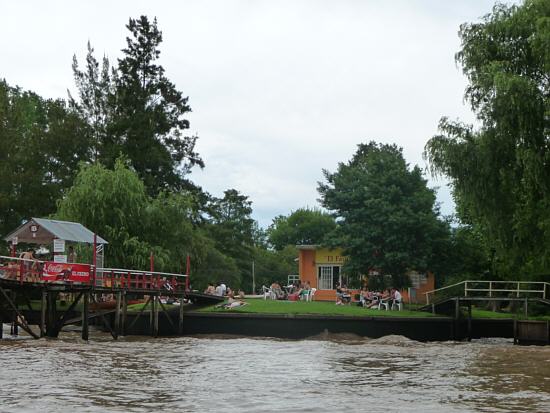 In the afternoon, a tour with a ship by the Delta was on the program.
But instead of the expected uninhabited islands have this area as a river Delta, interlaminated with channels.
It is used as recreational area - of untouched nature there was nothing to discover.
It seemed to me as almost all inhabitants of the city were there.
In the evening starts the night flight back to the cold Germany.
In the afternoon, a tour with a ship by the Delta was on the program.
But instead of the expected uninhabited islands have this area as a river Delta, interlaminated with channels.
It is used as recreational area - of untouched nature there was nothing to discover.
It seemed to me as almost all inhabitants of the city were there.
In the evening starts the night flight back to the cold Germany.
Amateur radio 
Unfortunately, there was nothing to be active as amateur radio operator from South America.
How the experience now teaches me, I need to accommodate the pole during the next visit inside the luggage.
So it can no longer lost.
Of course the entire travel bag can missing.
But in this case I will feel probably no good mind due to missing clothing and not to be game to operate.
The mast has not found until this day (three weeks after return).
Although I received a phone call a day after my return from the airport in Buenos Aires, but nothing further happened.
So if you met in the south of Argentina a rouming around DK9SQ fiberglass pole, please acquire it and give it a new home.
Weather and clothing 
If on the northern hemisphere dominates severe winter on the southern hemisphere dominates mid summer.
But a beach holidays was not there.
The existing south land area is much lower than those in the northern hemisphere.
The two near each other located oceans (Atlantic Ocean in the east and the Pacific in the west) influence Tierra del Fuego and Patagonia very much.
Overall the climatical resembles there quite rough and not to compare with a summer at a region with same latitude on the northern hemisphere.
We were lucky to get some drizzle only on two days.
Apart from that it was although cloudy and temporarily windy but dry.
Even at a few days very high standing sun burned down on us.
At night the temperature is falling often down at 0 °C.
This temperature depending on the sunshine day also increase ever to 25 °C.
12 to 15 °C reach them on average.
In the summer months (December to February), only 5 to 20 °C prevail in Ushuaia.
According to statistics, there should be sunshine to only about 40 to 50 days.
I am sorry that we "have consumed" already many of them during our trip and now, it's so much is left for other travellers.
Roland also reported that one day can also bids all seasons at once: first brightly sun like in summer, then rain like in spring, followed by storms like in autumn and snow like in winter.
Who attude to everything with several layers of clothing, or has it at hand, who nothing can happen.
When a change in the weather draws one putting somewhat on or off.
In the luggage are takes definitely a rain jacket, rain trousers, nonskidy and water-resistant walking shoes, a not blowing away hat, at least a thick sweater but also protection against the sun.
Sneakers do not belong in the luggage as umbrellas (might blow away with the protagonist).
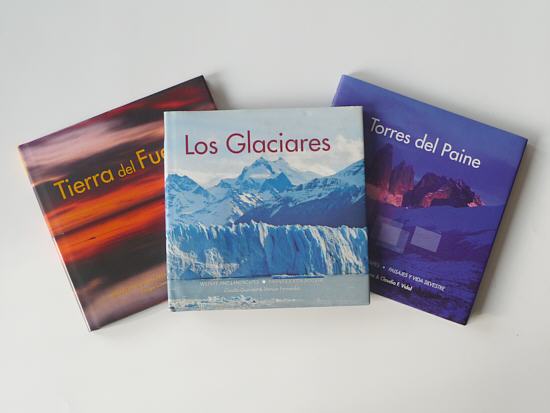 But no matter what purpose you come to this tip of the earth.
In any case, you will discover an area characterised by its wild beauty.
Succeeded us despite the approximately 2000 km, which we gone, we catch sight only of a small part of Tierra del Fuego and Patagonia.
Tierra del Fuego and Patagonia have to offer much more, as illustrated books available in the cities show.
It is a region you can visit confidently twice at other times of the year, without danger to visit only familiar things.
But no matter what purpose you come to this tip of the earth.
In any case, you will discover an area characterised by its wild beauty.
Succeeded us despite the approximately 2000 km, which we gone, we catch sight only of a small part of Tierra del Fuego and Patagonia.
Tierra del Fuego and Patagonia have to offer much more, as illustrated books available in the cities show.
It is a region you can visit confidently twice at other times of the year, without danger to visit only familiar things.